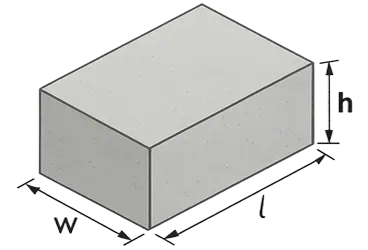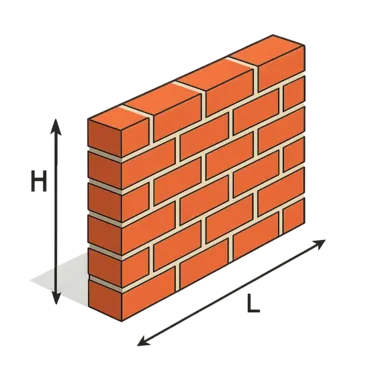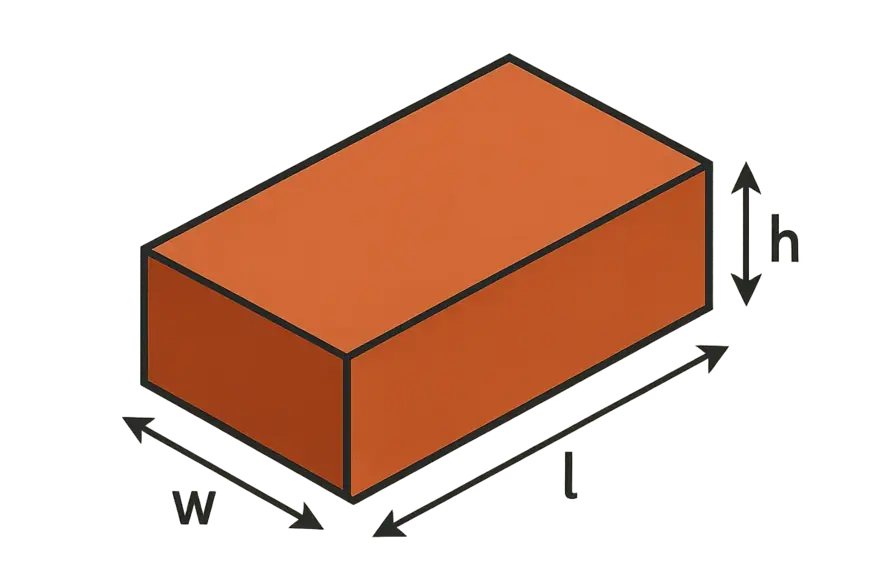Brick Calculator
Introduction
Whether you're planning to build house, garden wall or a home extension, our free brick calculator helps you determine the exact number of bricks you’ll need. Designed specifically for UK building standards and custom alterations, it ensures accuracy and convenience for laymen and professionals alike. This tool saves time, reduce wastage and helps you as a project estimator. It has all type of standard bricks and blocks dimensions.
How to Use the Tool

How Brick Calculator Work
Our brick calculator uses a simple and accurate formula to estimate how many bricks are needed for any wall, single skin or double. It considers the wall area, brick size, mortar joint thickness and wastage percentage of bricks on site, to give a realistic result.
Main Formula for calculating bricks:
Number of Bricks = Wall Area / Brick Area (including mortar joint)
Where:
- Wall Area = Wall Length × Wall Height
- Brick Area = (Brick Length + mortar joint thickness) × (Brick Height + mortar joint thickness)
Example:
Let’s say your wall is 3 m long and 2.4 m high.
Standard brick size = 215 × 65 mm
Mortar joint = 10 mm (added on both length and height)
First convert brick size in millimeter (mm) into meter (m):
215 × 65 mm becomes 0.215 m × 0.065 m
Brick Area with mortar = (0.215 + 0.01) × (0.065 + 0.01) = 0.225 × 0.075 = 0.016875 m²
Wall Area = 3 × 2.4 = 7.2 m²
Number of Bricks = 7.2 ÷ 0.016875 ≈ 427 bricks
So, for a wall 3 m long and 2.4 m high, you’ll need around 427 bricks.
Adding a small allowance (5–10%) for wastage or cutting, that’s about 450 to 470 bricks in total.
| Parameter | Value |
|---|---|
| Wall length | 3 m |
| Wall height | 2.4 m |
| Standard brick size (L × H) | 215 × 65 mm → 0.215 × 0.065 m |
| Mortar joint | 10 mm → 0.01 m |
| Calculated bricks (no allowance) | ≈ 427 |
| With 5–10% wastage | ≈ 450 – 470 bricks |
So, for a wall 3 m long and 2.4 m high, you’ll need around 427 bricks (or about 450–470 including wastage).
Block Calculator
This is a multipurpose tool which not only help you calculate number of brick but also required number of blocks for your project. From “select unit type” option chose “blocks” and be ready to estimates the exact number of concrete blocks needed for any wall based on its length and height. It uses the standard UK block size of 440 × 215 × 100 mm as default, including the mortar joint thickness for accurate results. For projects using different block sizes, a custom input option lets you enter your own dimensions, ensuring flexibility for all construction types.
Why add Wastage?
No construction site is perfect, and a bit of material waste is normal. When planning your brickwork, don’t stop at just the wall area and brick size, always add about 5–10% extra bricks. It helps cover small losses and breakages on-site. Otherwise, you might end up short later, costing you extra time and money.
Mortar Calculation, Calculate Sand and Cement for Brick/BLock Work
Mortar mix ratio is a ratio in which the cement and sand is mixed up to make mortar. It is written in n:m format, where the first number shows units of cement used and the second shows units of sand used in the mortar. For example, a 1:3 mix ratio means that to make mortar, 1 unit of cement is used against every 3 units of sand. A unit can be anything, like a bucket, shovel, or wheelbarrow.
1:3 is a rich, strong mix (contains more cement). It’s used for load-bearing brickwork, foundations, and retaining walls. It is not easy to work with and costly but has excellent strength.
1:4 is a general-purpose mix, used for standard brick walls (internal or external) and most block work. It has balanced strength and workability. This is the most commonly used ratio for general masonry work.
1:5 is a moderate mix, used for internal non-load-bearing walls, partition walls, and general work in mild exposure conditions. It’s easier to work with and economical but has lower strength.
1:6 is a weak mix best for low-strength block work. It is very economical and not recommended for structural masonry.
Formula for Cement and Sand Calculation in Brickwork
Let’s learn how to calculate cement in brickwork and the formula for converting mortar volume to cement bags (25 kg), with an example.
Let:
- Vₘ = Volume of mortar required (m³)
- C = Parts of cement in mix ratio
- S = Parts of sand in mix ratio
- ρ₍cement₎ = Density of cement = 1440 kg/m³
- Bag weight = 25 kg
Step 1: Total Parts of Mix
Total parts = C + S
Step 2: Cement Volumes
Cement volume = Vₘ × C / Total parts
Step 3: Sand Volume
Sand volume = Vₘ × S / Total parts
Step 4: Convert Cement Volume to Weight
Cement weight (kg) = Cement volume × ρ (cement)
Step 5: Convert Cement Weight to Number of Bags
No. of bags = Cement weight (kg) / Bag weight (kg)
Example:
Suppose you need 1 m³ of mortar with a 1:4 mix (Cement : Sand), and bag weight is 25 kg.
- Vₘ = 1 m³
- Mix ratio 1:4 → C = 1, S = 4
- Total parts = 1 + 4 = 5
Step 1: Cement Volume
1 × 1 / 5 = 0.20 m³
Step 2: Sand Volume
1 × 4 / 5 = 0.80 m³
Step 3: Cement Weight
0.20 × 1440 = 288 kg
Step 4: Number of 25 kg Bags
288 / 25 = 11.52 bags ≈ 11.5 bags (25 kg each)
Final Answer for 1 m³ of 1:4 Mortar (No wastage):
- Cement: 0.20 m³ → 288 kg → 11.5 bags (25 kg each)
- Sand: 0.80 m³
How Much Mortar is Needed Per m² of Brick/Block Work?
The volume of mortar for typical brick walls built with standard brick size (215 × 102.5 × 65 mm) and 10 mm joints is around 0.022 m³ per square meter of wall.
In simple terms, for every 1 m² of single-brick wall, you’ll need roughly:
- About 0.02 m³ of mortar in total
- Which equals roughly 2.5 – 3 kg of cement (using a 1:4 mix)
- And around 12 – 15 kg of sand
If the wall is thicker, like a double-brick or cavity wall, you’ll need roughly twice that amount because two brick layers are being laid side by side.
Imperial v Metric Units
The unit selection feature in our tool makes calculations simple and convenient for everyone. Whether you prefer imperial units (feet and inches) or metric measurements (meters and millimeters), you can switch between them instantly with a single click.
This flexibility ensures accurate results no matter where you are in the world or what measurement system your project follows. Builders, architects, and DIY users all benefit from this dual-unit option. It eliminates conversion errors and saves valuable time.
Standard Size Calculator
Our brick calculator is made to keep in mind one thing only, user friendliness. It requires minimum inputs from users to calculate bricks required for different wall projects. For the ease of users, standard size of brick and blocks are given by default with mortar mix ratio. Imperial measurement system is selected by default, It automatically adds in standard brick dimensions (length x width x height) 215 x 102.5 x 65mm and mortar joint of 10mm for bricks calculation of wall.
Brick and Block Details:
Knowledge about types and sizes of bricks and blocks is a must for accurate construction planning. In the UK, the most commonly used brick size is standard metric brick, measuring 215mm x 102.5mm x 65mm. Concrete block or breeze block is also used, with dimensions like 440mm x 100mm x 215mm being typical. Our brick calculator factors in popular UK brick and block sizes, making it easy to estimate requirements with precision. We also account for mortar usage, typically 10mm, which influence how many bricks fit per square meter. This makes our brick calculation more realistic. Our calculator allows you to switch between brick and block options depending upon your project.

Standard Brick and Block Sizes (UK)
| Type | Size (mm) (L × W × H) | Size (inches) (L × W × H) | Common Use |
|---|---|---|---|
| Standard Brick | 215 × 102.5 × 65 | 8.46 × 4.04 × 2.56 | Used for general walling, internal and external walls, houses |
| Tall Brick | 215 × 102.5 × 73 | 8.46 × 4.04 × 2.87 | Used where slightly thicker courses or decorative work is needed |
| Oversized Brick | 215 × 102.5 × 75 | 8.46 × 4.04 × 2.95 | Common for non-standard walling, restoration, or custom designs |
| Lightweight Block (Standard) | 440 × 100 × 215 | 17.32 × 3.94 × 8.46 | Used for single-skin walls, inner leaves, and partitions |
| Medium Block | 290 × 100 × 215 | 11.42 × 3.94 × 8.46 | Ideal for smaller walls or repair work |
| Standard Block | 390 × 100 × 190 | 15.35 × 3.94 × 7.48 | Used for load-bearing and general wall construction |
| Large Format Block | 630 × 100 × 215 | 24.80 × 3.94 × 8.46 | Used in large-scale masonry for quicker coverage |
| Thick Large Block | 630 × 100 × 250 | 24.80 × 3.94 × 9.84 | Used for structural or retaining walls needing added strength |
| Extra Large Block | 630 × 100 × 350 | 24.80 × 3.94 × 13.78 | Used for heavy-duty load-bearing or retaining applications |
Bricks Required
During the planning phase of any construction project, estimating the number of bricks required is one of the most important steps. Regardless of the type of wall you are building, knowing the correct quantity of brickwork helps ensure your project runs smoothly while saving money and materials. Our Brick Calculator UK makes this task quick and easy by serving as an estimator based on your wall dimensions and brick type, completely free to use.
Custom Size Calculator
Our brick wall calculator is truly a customizable tool, it gives user complete freedom of choice regarding all calculating elements. It offers plenty of size standards given for both bricks and blocks, users can also manually input the sizes by selecting custom button. Option is given between choosing imperial and matric measurement system. Then comes the wastage of brick and mortar selection option, both are fully customizable.
Mortar Calculator for Brick
Easily work out how much mortar you'll need for your project using our brick mortar calculator . This handy tool provides an accurate estimate of the materials required for brickwork of any wall, based on UK construction standards. The tool shows the cement quantity in 25kg bags and sand volume in cubic meters or cubic feet. To find the amount of cement in kilograms, simply multiply the number of bags by 25. It's a fast, reliable way to plan your brickwork with confidence.
Masonry Work Guidelines & Safety Tips
Before starting any brickwork, take time to set out the wall lines carefully and confirm all levels are accurate. Choose solid, even bricks and prepare a stable base. Lightly wet the bricks so they don’t pull moisture too quickly from the mortar.
Safety on Site
Wear basic protective gear including a helmet, gloves, and sturdy footwear. Check scaffolding and ladders every day to ensure they’re stable. Keep the workspace tidy so tools, bricks, or mortar piles don’t become tripping hazards. Always keep a safe distance from areas where work is happening overhead.
Laying Bricks the Right Way
Build the corners first, then run a tight string line to keep your courses straight. Maintain equal joint thickness throughout the wall for a neat finish. Regularly check with a level to make sure the wall stays plumb. Overlapping vertical joints properly increases strength and stability.
Mixing and Using Mortar
Prepare only the amount of mortar you can use within a short time to avoid waste. Keep the mix uniform and workable, don’t try to revive it with extra water once it begins to stiffen. Protect mortar from drying out too quickly, especially in hot weather.
Indoor and Outdoor Work
For exterior walls, shield fresh work from direct sun or rain. Inside, make sure there’s enough light and airflow to work accurately. In hot climates, keep bricks damp; in cold conditions, avoid working when frost is likely.
Finishing Touches
Clean up joints as you go to keep the wall looking sharp. Light brushing gives a smooth finish. Keep the wall damp for several days after completion to allow proper curing and strength development.
Frequently Ask Questions (FAQ's)?
In United Kingdom, when using standard brick size (215mm x 102.5mm x 65mm) with a typical 10mm mortar joint, you will need approximately:
- 60 bricks per square meter for a single skin wall
- 120 bricks per square meter for a double skin wall
This general rule helps you get a rough idea, but for a precise calculation, it is best to use our brick calculator, which adjusts automatically for wall height, length, type, and mortar.
Using a reliable brick calculator saves time and takes the guesswork out of planning. Instead of rough estimates, our tool delivers precise results tailored to your specific project requirements. After getting bricks number, one can get an idea about the cost of building walls for a house by multiplying total number of bricks with cost per single brick.
Enter dimensions of wall you are going to construct using our free brick calculator. Enter the brick or block dimensions in respective section and press calculate. You will get the required number of bricks with or without mortar and/or percentage of wastage.
Calculating the number of bricks for a 4 by 4 meter room depends on several factors, including the height of the walls, wall thickness, and brick size. Using our calculator you can get bricks number for one wall, by adding bricks for four walls, total number of bricks for any room can be estimated.
The area that 1,000 bricks can cover depends on the size of the bricks and whether or not you're including mortar gaps in the calculation. Using Standard Brick Size (with mortar):
- Typical brick size with mortar: 200 mm × 100 mm (0.2 m × 0.1 m)
- Area covered by one brick = 0.02 square meters
- 1,000 bricks × 0.02 m² = 20 square meters
So, 1,000 standard bricks can cover approximately 20 m² of wall area.
A pallet is a flat plastic or wooden platform used to store, stack and transport construction materials like cement, bricks and blocks etc., Pallet is made in such a way that it makes it easier for fork lifters and cranes to handle materials on them quite easily. Normally the size of the bricks decide how many will be in a pallet, most pallet hold somewhere between 400 to 600 bricks depending upon the manufacturers and brick sizes. Common standard pallet contain 430, 504 and 600 bricks.
For standard UK bricks (215 mm long + 10 mm joint = 225 mm length per brick), So in 1 linear meter number of bricks will be; 1000 mm ÷ 225mm = 4.44 bricks (as 1m=1000mm) So, you’ll need about 4½ bricks per linear meter for a single course of wall. When you lay bricks width-wise (called a header course), the brick’s 102.5 mm width plus a 10mm mortar joint gives a total of about 112.5 mm per brick.Now divide 1 meter by that length: 1000mm÷112.5mm=8.881 m So you’ll need around 9 bricks per linear meter when laid width-wise
It depends upon what size of blocks you are using, for calculation purposes, we will use a standard block size of 440mm x 215mm x 100mm, and at this size you will need 10 blocks per square meter for a single skin wall and 20 for double skin wall. Off course this calculation includes the mortar joint of 10mm, as no one want to just stack up their blocks in a wall. It needs to bond together with its neighboring blocks and a 10mm mortar joint is perfect for it.
Yes you can, openings like windows and doors are common in brick walls, Just calculate the wall area and subtract the area of opening(doors, windows) from wall area. If you have multiple openings in the wall, sum all the opening area and subtract from the wall area, you will find your exact brick count for the wall e.g. area of opening 1+area of opening 2+area of opening 3+… = total area of all openings Bricks area = wall area – total area of all openings

